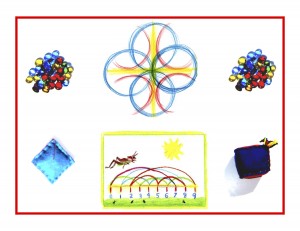Day 64
For one year, 365 days, this blog will address the Common Core Standards from the perspective of creating an alternate, ambient learning environment for math. Ambient is defined as “existing or present on all sides, an all-encompassing atmosphere.” And ambient music is defined as: “Quiet and relaxing with melodies that repeat many times.”
Why ambient? A math teaching style that’s whole and all encompassing, with themes that repeat many times through the years, is most likely to be effective and successful. Because the Common Core Grade 1 Math Standards address addition and subtraction exclusively, they will not appear here until math blocks 3 and 4: the 4 Processes. Math blocks 1 and 2 focus on meeting the numbers up close and personal, through stories, movement, art, and hands-on activities like making real numbers. (Note that Grade 1 math could be divided into three blocks of 20 days each: Number Forms/Real Numbers/4 Processes & Practice, or four blocks of 15 days each: Number Forms/Real Numbers/4 Processes/4 Processes Practice.)
The recommendation throughout the Kindergarten posts here was to compute using symbols rather than the Arabic numerals, since they are too abstract to use until they are properly introduced. After the Roman numerals are taught with a story and yesterday’s hand trace, the Arabic numerals can follow suit. There are many theories about the origins of the Arabic numerals, and it almost doesn’t matter which one is chosen, but it is necessary to place the Arabic numerals in some sort of context. Note that the concept of zero is essential to grasp for computation to take place, and it’s an especially difficult one to explain. Consider that it was only adopted in Europe in the ninth century, after a monumental struggle, especially with the Catholic church! As always, story and illustration are the vehicles of choice for optimal teaching and learning.
Math By Hand now has a Daily Lesson Plans supplemental book for Grades 1 and 2. The story of how the Roman numerals came to be is taken from the very end of the first math block, and could be told before doing yesterday’s hand trace drawing . . .
Roman Numerals
Once when the world was very young, the sun shone gold as it does today, but many things were very different. Straight brown sticks and small smooth stones were piled up at every door of every house, to be used for counting. You see, there were no numbers then, but so many things still needed to be counted! In order to count things, the small smooth stones or the straight sticks were gathered in groups to show how many.
One day a small boy used a stick to make marks in the soft, flat ground at his doorstep to show how many ears of corn he had picked that day. And those marks became the first written numbers. Then a little shepherd girl in the desert (where there were no trees, no branches, and no sticks) began counting on her fingers. And so it was for a long, long time.
Until, in a city of seven hills called Rome, written numerals were used. The Roman numerals looked like counting on your fingers: one finger (one straight line) was used for the number 1, two straight lines for the number 2, three straight lines for the number 3, but “V” was used for the number 5! Look at your hand. See if you can find the V for the number 5.
Tune in tomorrow for the story of the Arabic numerals’ beginnings, and how they first appeared. Remember that knowledge ensues in an environment dedicated to imaginative, creative knowing, where student and teacher alike surrender to the ensuing of that knowledge as a worthy goal. More Grade 1 numbers tomorrow!












